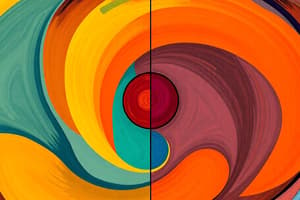Podcast
Questions and Answers
Which of the following accurately describes a phase change?
Which of the following accurately describes a phase change?
- A transformation in the state of matter of a substance due to gain or loss of energy, while maintaining its chemical identity. (correct)
- A process where a substance's chemical composition is altered by adding or removing energy.
- A reaction that occurs when different substances are mixed together, resulting in a new state of matter.
- A change in the physical appearance of a substance that always involves a change in temperature and pressure.
How does the energy content of molecules differ between solid, liquid, and gaseous phases of a substance?
How does the energy content of molecules differ between solid, liquid, and gaseous phases of a substance?
- Liquid phase molecules always have the lowest energy because they are less structured than solids and less energetic than gases.
- Gas phase molecules contain the most energy, liquid phase molecules have an intermediate amount, and solid phase molecules have the least. (correct)
- Energy content is identical across all three phases; phase change is determined solely by pressure, not energy.
- Solid phase molecules possess the highest energy, followed by liquid, and then gas phase molecules.
What is indicated by the 'triple point' on a phase diagram?
What is indicated by the 'triple point' on a phase diagram?
- The unique set of temperature and pressure conditions where a substance can exist in solid, liquid, and gas phases simultaneously in equilibrium. (correct)
- The maximum temperature and pressure a substance can withstand before undergoing chemical decomposition.
- The temperature and pressure at which a substance becomes a supercritical fluid.
- The point beyond which the liquid and vapor phases of a substance become indistinguishable.
During a phase change like melting or boiling, what happens to the temperature of a pure substance as energy is added?
During a phase change like melting or boiling, what happens to the temperature of a pure substance as energy is added?
Which of the following best describes plasma as a state of matter?
Which of the following best describes plasma as a state of matter?
What is the primary composition of plasma as described?
What is the primary composition of plasma as described?
Which process describes the phase change of gallium when it melts in the palm of a hand?
Which process describes the phase change of gallium when it melts in the palm of a hand?
What is the process called when water vapor in the air turns into dew on grass in the morning?
What is the process called when water vapor in the air turns into dew on grass in the morning?
Dry ice transforming directly into carbon dioxide vapor exemplifies which phase change?
Dry ice transforming directly into carbon dioxide vapor exemplifies which phase change?
In the context of phase changes, what is deposition?
In the context of phase changes, what is deposition?
Flashcards
What is a phase?
What is a phase?
The state of matter a substance is in. The most common are solid, liquid and gas.
What is a phase change?
What is a phase change?
A process where a substance gains or loses energy, causing its molecules to move closer together or further apart. This changes the state of matter, such as solid to liquid or liquid to gas.
What is a phase diagram?
What is a phase diagram?
A diagram that shows the different phases (solid, liquid, and gas) of a substance at different temperatures and pressures.
What is the triple point?
What is the triple point?
Signup and view all the flashcards
What is plasma?
What is plasma?
Signup and view all the flashcards
What is a liquid?
What is a liquid?
Signup and view all the flashcards
How does boiling work?
How does boiling work?
Signup and view all the flashcards
What is condensation?
What is condensation?
Signup and view all the flashcards
What is sublimation?
What is sublimation?
Signup and view all the flashcards
Study Notes
Phase Changes
- Phase: A description of a substance's state of matter (solid, liquid, gas, or plasma).
- Solid: Atoms/molecules have low energy, are close together, have a definite shape and size.
- Liquid: Molecules have more energy than solids, less than gases, are fluid, take the shape of their container.
- Gas: Molecules have the highest energy, have no definite shape, fill the container.
- Phase Change: The process of a substance gaining or losing energy, causing molecules to move closer or farther apart, resulting in a change of state.
- Solid to liquid (melting/liquefaction)
- Liquid to gas (boiling/vaporization)
- Gas to liquid (condensation)
- Liquid to solid (freezing)
- Solid to gas (sublimation)
- Gas to solid (deposition)
Phase Diagram
- Phase Diagram: A visual representation of the phases of a substance based on temperature and pressure.
- Triple Point: The temperature and pressure where all three phases (solid, liquid, gas) can coexist.
- Critical Point: The point where the liquid and gas phases become indistinguishable; the boundary between them disappears.
- Supercritical Liquid: The state of a substance beyond the critical point, where the phases are indistinguishable.
- Melting Point/Boiling Point: Temperatures where a substance changes phases at a specific pressure. The temperature and pressure remain constant during these phase transitions.
Plasma
- Plasma: A state of matter consisting of positive ions and free electrons.
- Conditions: Super-heated substances, found in stars, lightning, and neon signs.
Phase Change Examples
- Melting (Liquefaction): Gaining heat energy, solids turn into liquids; An example with gallium.
- Boiling (Vaporization): Liquid becomes gas by absorbing sufficient energy, as seen with methanol.
- Condensation: Cooling gas into liquid. Gradual energy loss, Example (Dew formation).
- Freezing: Liquid becoming solid because of energy loss. Example (freezing water).
- Sublimation: Solid to gas without entering liquid phase; example with dry ice.
- Deposition: Gas directly into solid; example is the formation of soot on chimney walls.
Phase Changes of Water
- Water Cycle: The continuous movement of water between solid (ice), liquid (water), and gas (water vapor) states as part of ecosystems.
- Processes in the water cycle: Evaporation, Condensation, Precipitation, Deposition(cirrus clouds), and the melting of ice.
Studying That Suits You
Use AI to generate personalized quizzes and flashcards to suit your learning preferences.




